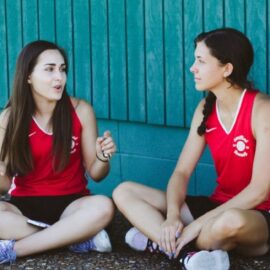

This article is an excerpt from the Shortform book guide to "Flow" by Mihaly Csikszentmihalyi. Shortform has the world's best summaries and analyses of books you should be reading.
Like this article? Sign up for a free trial here .
How can you find your inner flow by embracing your senses? Why is seeing one of the most overlooked ways to induce your inner flow?
In Csikszentmihalyi’s book Flow, he discusses how to enter a flow state solely by using your senses. Things like eating, listening to music, and even looking at art can help you enter a state of inner flow.
Here’s how you can reach a flow state by embracing your senses.
Inner Flow and the Senses
Like physical activity, different senses have corresponding flow experiences. This article offers an overview of the inner flow experiences associated with tasting, hearing, and seeing.
Note: Enjoyment comes from the process of engaging or disengaging the senses at will, and activities associated with either course of action can be enjoyable. For example, you could meditate in the afternoon, then go to an art gallery in the evening and both could provide enjoyment.
Taste: Eating and Cooking
Like sex, eating tends to be naturally pleasurable because we’ve evolved to do it for survival. In Csikszentmihalyi’s studies, people tend to feel most relaxed at mealtimes, and every culture has developed ways to make eating enjoyable. Until recently, U.S. food culture consisted of preparing food without delighting in the sensory experience it can provide. Now, “foodies” and others are making enjoyable eating more commonplace.
The world’s cuisines developed as a flow activity. People looked at the ingredients available and learned how to cook using the best techniques and combinations of ingredients. This kind of experimentation with food happened in all classes. Here are some examples:
- People learned that eggs help hold foods together and salt acts as a preservative.
- Those who worked for royalty searched for ingredients and cooking techniques to add variety to the royals’ diet.
- Some peasant women in Eastern Europe were expected to know how to cook a different kind of soup for every day of the year in order to be eligible for marriage.
But there are plenty of ways to not enjoy food. If you eat just to get the calories to live, you may find food pleasurable, but you won’t enjoy it. To find inner flow in eating and cooking:
- Focus attention on what you eat. Over time, you may develop a more discerning palate, take an interest in a certain kind of cuisine, and learn to produce a complete meal composed of various dishes. For example, someone who takes an interest in Middle Eastern cuisine may know where to get the best spices for a certain dish.
- Approach them with curiosity. This may help you cook and taste your food with more intention, learning to appreciate it. Enjoyment comes from feeling a sense of control over the experience.
- Be disciplined about your desires. As with other flow experiences, it’s possible to overdo it on food. This is one reason gluttony is a deadly sin in the Bible and Puritans eschewed enjoyment: If you take too much pleasure in sensory experiences, you’ll divert energy away from other pursuits and may develop an addiction. But avoiding something because you think you have to or you’re afraid of what it’ll do to you can make you defensive or closed-off. At that point, the self can’t grow and develop. Instead, enjoyment happens when you choose to be disciplined about your desires.
Hear: Hearing and Playing Music
Most cultures use music as a way of ordering consciousness. For example, hearing music can direct people to feel a certain way—solemn at funerals or energized at political rallies. It also helps restore order to our consciousness when a piece of information isn’t compatible with our goals. For example, one police officer reported listening to the radio to soothe himself after stressful workdays filled with making arrests.
These days, music is widely available on our smart devices and some argue that this wide availability improves our quality of life. But like other flow activities, it’s about paying attention to the activity, not your access to it—just because you can play music 24/7 doesn’t mean it’ll be a flow experience. If you take your access to it for granted, you might not enjoy it as much.
On the other hand, anticipating a concert for weeks and engaging with it deeply for the few hours it happens could be a flow experience. You might have a sense that the performance is special and won’t ever be repeated in exactly the same way, or you may feel a sense of belonging with a large group of people. Emile Durkheim refers to this as “collective effervescence”; concerts and religious events are two examples. Witnessing the same event, processing the same information as the group, and potentially feeling the same feelings are all ingredients for producing a flow experience.
Though listening to live music has the ability to focus your attention, it’s possible to find inner flow by listening to recorded sound, too. To do so, people tend to:
- Set aside time for listening.
- Create an appropriate listening atmosphere. This might include adjusting the lighting or sitting in a comfortable seat.
- Decide what they’ll listen to and what their goals are ahead of time.
The Three Levels of Engagement
There are three different levels of engagement with listening to music:
- Sensory. In this stage, you feel pleasure from hearing elements of sound that are naturally pleasing, such as the sound of chords, or the rhythm of the bass.
- Analogic. In this stage, you go beyond the sensory pleasures of music to think about the music, including the emotions or images it evokes in you. For example, one of Tchaikovsky’s pieces uses bells to conjure images of a horse-drawn sleigh moving through the forest. Certain songs help people reach this stage by providing lyrics that illustrate the emotion or story the song is conveying.
- Analytic. This stage is the most complex because it involves moving beyond the first two stages into processing the structure of the piece—how it creates harmonies, patterns, and more. For example, someone capable of accessing this stage may ask how two recordings of the same song by the same piano player differ and discover that in the later performance, they don’t play the piece as quickly.
Playing Music
Learning to make music can also provide enjoyment. You improve your sense of self through ordering sound with pleasing orders of notes, harmonies, and rhythms. For example, playing a symphonic instrument or singing in a choir are two easy ways to produce something orderly and pleasing while relating to your fellow musicians and an audience. You can also create music through software in real time. It’s best to learn to make music when you’re young, but it’s never too late to begin.
There are two main barriers children face to playing music:
- Lack of funding for music education. Many children learn to appreciate music and play instruments at their schools, but when funding for schools is tight, music education is often cut.
- Pressure to perform well. It’s common for parents to pressure their children to perform well rather than enjoying the experience of playing. Pressure can make music into a dreaded experience rather than an enjoyable one. In one extreme case, Lorin Hollander, a child piano prodigy, experienced so much pressure to perform well from his father, a professional violinist, that his hands became clawed and paralyzed during a recital. Hollander was so worried about criticism that his subconsciousness took over and prevented him from playing and having to face it. Eventually, he was able to play again and now helps young, gifted musicians find enjoyment in their musical practice.
See: Looking at Cities, Nature, and Art
Seeing is one of the most overlooked ways to cultivate enjoyment. We typically use this sense for basic tasks, like finding our sunglasses or staying on a paved path. Sometimes, we’ll pause to admire an especially beautiful sight, but most people don’t train themselves to use their vision in more enjoyable ways.
Some seeing activities that produce flow include:
- Interpreting a cityscape. Though a fairly commonplace experience, the extra attention it takes to look closely at a city and note its architectural features can provide an enjoyable experience. One study participant reported doing this activity each workday during his commute on the elevated train, noting that it makes him feel part of the city while also being removed from it.
- Staring at nature. You can derive enjoyment just by looking at a nature scene because it offers many different visual stimuli—stars, waves, leaves—and may change day-to-day.
- Looking at a work of art. Seeing a good piece of art can be pleasing to the eye, and it’s enjoyable when you gain a better sense of the world or your place in it. It may provide an opportunity to abandon your own self and feel a connection with others. For example, looking at a painting of bathers in the river on a summer day may help you understand that experience even if you’ve never done that activity.

———End of Preview———
Like what you just read? Read the rest of the world's best book summary and analysis of Mihaly Csikszentmihalyi's "Flow" at Shortform .
Here's what you'll find in our full Flow summary :
- Why people feel the happiest when they're in the "flow state"
- What activities and personality traits promote flow
- Why you may have a paradoxical relationship with work and leisure






